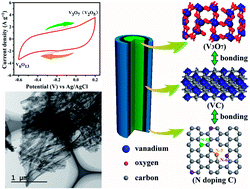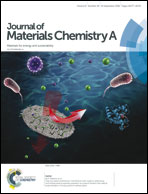Nest-like V3O7 self-assembled by porous nanowires as an anode supercapacitor material and its performance optimization through bonding with N-doped carbon†
Abstract
Vanadium oxides (such as V2O5, V2O3 and VO2) hold great promise as electrode materials for energy storage due to their high electrochemical activity, low cost and environmental benignity. However, V3O7 is rarely investigated as a supercapacitor material. Herein, nest-like V3O7 self-assembled by porous V3O7 nanowires was fabricated. The energy storage mechanism of V3O7 was investigated at different reaction potentials. It was found that V3O7 was converted to V6O13 at a potential of −0.6 V, and became V2O5 at 0.2 V. Additionally, an in situ photopolymerization method was introduced to synthesize V3O7@polypyrrole (PPy) and then, V3O7 nanowires coated with a layer of N-doped carbon were obtained after calcination to enhance the performance in terms of capacitance and stability. This unique N-doped carbon coated nest-like V3O7 (NC-V3O7) exhibited a high specific capacitance of 660.63 F g−1 at a current density of 0.5 A g−1 and even reached 187.72 F g−1 at a high current density of 50 A g−1. According to this investigation, the superior performance of NC-V3O7 is attributed to the synergy between N-doped carbon and V3O7, that is, the unique three layer structure (C bonded both to V and N) stabilized V3O7 and supported high-speed ionic and electronic transmission channels. Finally, full symmetric (NC-V3O7//NC-V3O7) and asymmetric (MnO2 nanosheets//NV-V3O7) supercapacitor devices were assembled and showed higher power and energy density than those of related reports.



 Please wait while we load your content...
Please wait while we load your content...